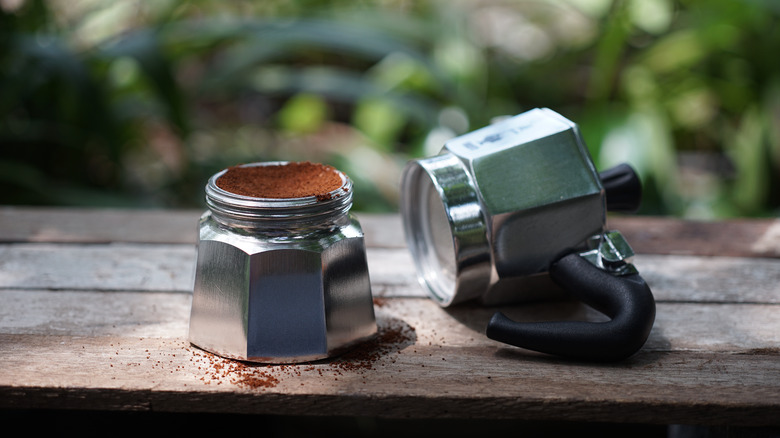Should You Tamp Coffee Grinds When Using A Moka Pot?
While latte art and at-home espresso machines are relatively new, the moka pot is a coffee and espresso maker that was designed for the stovetop back in 1933. Since it was one of the first products that brought fancy espresso into people's homes, there was some trial and error that came with the unique invention. The product has Italian roots and its longevity speaks to the quality of this technique.
A moka pot has an hourglass shape with a handle. Water gets placed in the bottom compartment and a metal filter with added coffee grounds sits above it. Once the top compartment is secured into position, it gets placed on the hot stove. As it heats, the steam infuses with the grounds, creating a pressurized funnel that allows hot coffee to fill the top compartment.
While the grind of the coffee and roast of the bean are important factors, opinions differ when it comes to whether or not you should be tamping the coffee grounds in a moka pot. According to Bialetti, you should never press the grounds into the filter. Instead, you should fill the coffee grounds to the top, make the pile level, and leave space for water to easily pass through the grounds. Similarly, others find the tamping step unnecessary due to the pressure it creates inside the pot, which could lead to a very hot coffee explosion. Not to mention that this can over-extract the beans, which will leave you with bitter-tasting coffee.
Most moka pot lovers avoid tamping
A medium-coarse grind on coffee beans is the ideal texture for a moka pot because it allows the water to cover each grain and absorb that full-bodied flavor. However, allowing too much air in between the coffee grounds will leave you with weak coffee. Similarly, applying too much pressure to your grounds can also weaken your brew. Since a moka pot is designed to make coffee shop-quality espresso, tamping the grounds effectively will theoretically slow down the brewing process and allow the water to retain that strong, bold flavor.
Some coffee connoisseurs also note that tamping the grounds can help to create that foamy crema on the top of the espresso. Ideally, gentle tamping will provide the best results for those in favor of it. However, it is a controversial choice that doesn't always lead to your best cup of coffee. A good middle ground would involve tapping the side of the moka pot to settle the grounds or applying minimal pressure with a spoon to make an even layer on top.
Ultimately, tamping your coffee grounds in a moka pot comes down to personal preference. While the technique does change the flavor and strength of your espresso, other factors like grind and roast also play a role. Therefore, experimenting with your moka pot and opting for the process that gives you your preferred flavor profile is the best approach.

